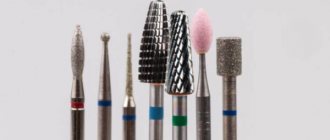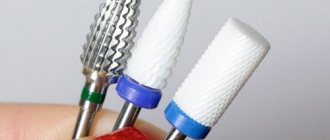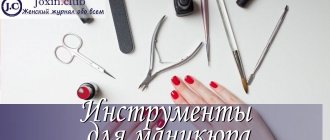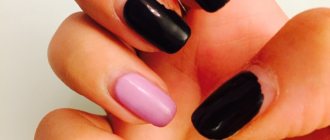What is the difference between manicure cutters and pedicure cutters?
When processing the skin around the nail and cuticle, there are no specific differences between manicure and pedicure cutters. The only way they may differ from each other is their rigidity parameters and dimensions. In pedicure, you have to work with a large surface area, so you should choose the appropriate cutters.
The skin on the heels and side bolsters is rougher. When working with a dead area, you need to put more effort into removing the top layer. A simple milling cutter cannot cope with pressure - you need to select not only the number of revolutions per minute and the power of the milling cutter, but also the material of the nozzles.
Cutters for manicure and pedicure: what is the difference
To work with cuticles and nails of the hands and feet, they are treated with the same cutters, the only difference is that for pedicure they use harder attachments - this is necessary in order to quickly treat a larger area and rougher skin of the feet.
But in pedicure there is a stage that is not in manicure - this is working with the feet: removing cracks, removing corns and calluses, grinding and polishing the skin. And here you will need additional attachments - a large “needle” for working with cracks, grinders and polishers, “drum” shaped attachments.
Material of nozzles for manicure apparatus
There are several cutters based on the type of coating and base:
- carbide;
- with ceramic coating;
- with diamond coating;
- grinding;
- corundum;
- sand;
- silicon carbide caps.
Carbide cutters are made from hard metal alloys on which notches are cut. As they rotate, they remove a layer of skin as much as the cutter allows. Such manipulations level the surface.
The greater the depth of the notch, the more pronounced the mark from processing by the device at high speeds.
Ceramic ones are made of metal, on top of which a ceramic coating is applied. Unlike the previous type, they are quite fragile. Upon impact, chips and cracks may form. Diamond cutters have a wide variety of hardness, it all depends on the degree of abrasiveness of the spray.
Corundum nozzles are produced for processing artificial materials. They are resistant to high temperatures. When heated at the moment of rotation, the nail does not injure.
Sand caps are suitable for pedicure:
- treatment of corns;
- cut of rough skin;
- polishing calluses.
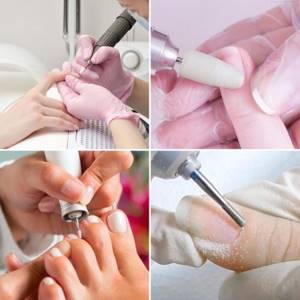
The base is cardboard, which is sprayed. Disposable caps are equipped with additional rubber attachments that are sterilized after each use.
Grinding cutters come in rubber, silicone and fabric. Apply to sensitive areas with the addition of oils, creams or liquids designed to soothe irritation.
Silicon carbide
The caps are placed directly on the stem. They are designed for grinding, removing old coating, and removing rough areas of skin. The abrasive is applied to a polymer, cardboard or rubber base. There are also samples with a textile and silicone base on the market.
The advantage of silicon carbide samples is their relatively low price and versatility. Caps are also required for foot treatment. But at the same time, they serve very little, since the soft base wears off quickly.
Types of cutters according to rigidity
The rigidity is determined by the marks that are on the base of all cutters.
They are grouped into categories:
- high rigidity;
- medium abrasiveness;
- soft and very weak texture.
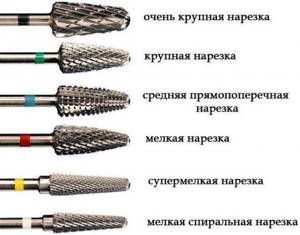
The marking is located on the cutter base ring:
| Black | High hardness is suitable for hard coatings: gel, acrylic, acrylic, gel polishes. |
| Blue | Medium abrasiveness is intended for grinding side ridges and cuticles, if they are not thin. Suitable for filing soft materials, but only as tools for leveling gel and acrylic coatings. Not suitable for cutting artificial nails. |
| Green | Medium hardness, but not recommended for working with leather. Such cutters are not suitable for people with hyperhidrosis - they cause irritation. |
| Red | Soft attachments suitable for working with leather and natural plates. Diamond-coated bits with two notches indicate increased softness of the tool. |
| Yellow | Very soft attachments that are recommended for those who experience irritation and allergic reactions. The yellow cutter is well suited for working with thin skin in manicure. |
| White | Used for processing natural plates with high sensitivity of the integument. |
Attachments for manicure apparatus, depending on the degree of abrasiveness, are used when working with gel polishes, acrylic and gel materials, taking into account the type of skin.
How to insert a cutter into the machine
The steps depend on which machine you are using - manual, semi-automatic or automatic clamping.
• For manual clamping: press the button on the body, unscrew the washer, remove/install the cutter, hold the button, tighten the washer.
• For semi-automatic clamping: turn the top part clockwise until it clicks (about half a turn), remove/install the attachment, turn the section counterclockwise.
• For automatic clamping: turn off the device, pull and remove the cutter, insert a new one and turn on the device.
For more information about replacing cutters and frequently encountered problems, read the article “How to remove the attachment from a manicure machine.”
Types of attachments by function
At each stage of work, different cutters are used:
- Any cutter equipped with teeth is suitable for removing artificial material. For gel polish, the recesses should reach 1 mm, and nozzles for dense layers (gel and polygel) - up to 2 mm. Large threads leave grooves, after which you need to use buffs and files.
- Cone-shaped nozzles are suitable for processing glossy surfaces. They provide good contact with a large surface area.
- Diamond cutters are needed to work with sinuses and pterygium. They clean out debris well and lift the skin at the cuticle. There are galvanic, sintered monolithic tools with different abrasiveness. Their markings begin with a white notch.
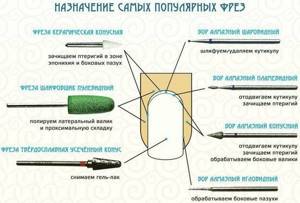
Reversible cutters can be used by left-handed or right-handed people. Material removal will be smooth regardless of the direction of movement.
Carbide
Models made of steel with tungsten and carbide are popular on the market. Notches on the outer layer form a rough surface. Both options have a long service life, but tungsten ones have a higher hardness coefficient.
The principle of operation of a carbide cutter is to instantly penetrate the surface being processed. It cuts through artificial turf like a knife with a microscopic blade. In one step, the specialist removes a groove, the depth of which is equal to the size of the blade.
Popularity is determined by the following qualities:
- Successful work with hard surfaces.
- High performance. In one pass along the plate, up to 1 mm is removed.
- Possibility of forming shaped recesses for rhinestones (or stones).
- Long shelf life. Even after the longest use, the tool remains invulnerable to corrosion processes.
- Easy care. Disinfection and disinfection are carried out with any antiseptics. The head material exhibits a neutral reaction to interaction with compounds that have a complex chemical formula.
- The tool is also relevant for pedicures. It is used to remove calluses and file the end of the nail plate.
The rotation speed is 15,000 revolutions per minute. With active use, the equipment will last six months. From the same series, more durable models are equipped with additional coating: titanium or galvanic gold. The degree of wear of the notches is clearly visible on them.
The downside is that the head gets very hot during the procedure. The client may complain of overheating and a slight burning sensation. At the same time, the possibility of traumatic situations remains. The master requires a lot of experience and caution to avoid cutting through the nail. If qualifications are not yet sufficient, then it is recommended to use a safer option.
Types of cutters by shape and purpose
Attachments for manicure apparatus come in different shapes - this ensures high-quality work when cleaning and leveling the nail plate.
Flame
This is the most popular nozzle, which, depending on the thickness and length, is capable of treating all the internal parts of the nail. Due to its small diameter, it is able to penetrate deeply, opening the areas of the pterygium. When working with “flame” you need to hold the cutter at an angle of 45°. If it adheres to the nail, cuts may form.
Needle
It is convenient for cleaning those areas under the cuticle that were “hidden”. A needle with a small diameter can be used to reach the growth lines in the side ridges. The fissure attachment is also convenient for filing and correcting real nails.
Corn
The attachment is convenient for cutting the length of an artificial nail and reducing the thickness at the end. There are tools made of carbide material and with ceramic coating.
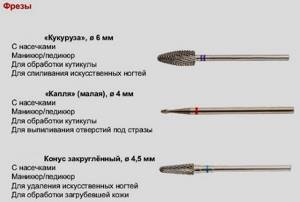
To remove color coating or design, it is important to hold the cutter parallel to the natural nail. Despite the shape and depth of the thread, it is recommended to operate at 20,000 rpm to avoid cuts.
Cone
This is the most popular tool for opening and lifting the cuticle to treat the space underneath and cut the skin. A diamond or corundum cone does not injure the skin. The nozzle must be held at a right angle to form a “skirt” of the cuticle.
Ball or sphere
The cutter comes in different diameters. Its direct and only purpose is to remove the cuticle. Depending on the color of the notch, the speed of rotation and the force of pressing on the skin are selected. Small balls can be used to remove pterygium if you cannot cope with it using other attachments.
Lentil or bullet
Expanding tips are necessary for deep penetration into the space between the nail and the skin. The bullet, due to its thin “nose”, penetrates into the sinuses, and with its “belly” it expands the area. The opened cavity must be cleaned with other cutters.
Drum or cylinder
A cutter of this shape is convenient for working with side rollers. Large attachments are intended for external work, narrow and thin – for treating the inner part of the skin around the nails.
Roller or rounded cylinder
This cutter is required to process the transition zones of the cuticle into the side roller. Due to the smoothed corners, the risk of injury is almost minimal.
Materials: types, features, pros and cons
The main purpose of manicure cutters is to tidy up your nails without damaging them . Therefore, you should choose the material from which they are made very carefully. Each has both its advantages and disadvantages.
Pomegranate
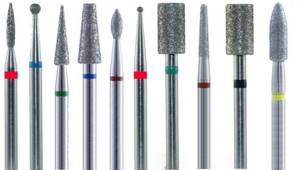
New generation nozzles made of a polymer base coated with pomegranate crumbs. Thanks to its plastic structure, it does not damage the surface of the nail and the skin around it. The range of uses for garnet cutters is quite wide. Depending on the form, they are used for:
- correction of natural nails;
- cuticle treatment;
- preparation for extension;
- removal of calluses;
- polishing rough skin.
The main advantages are delicate processing and lack of heating . Corundum cutters have no disadvantages. The average service life is 3 months.
Reference! Due to the delicacy and safety of the material, you can use pomegranate tips yourself at home.
Silicone

Silicone cutters are used only for final nail processing - polishing and eliminating minor coating defects. There are 3 types of silicone tips:
- coarse for removing artificial turf and eliminating roughness;
- medium for grinding;
- soft for polishing.
They are distinguished by the color of the cutter; the darker it is, the tougher it is. The advantages of silicone cutters include :
- antistatic (no tendency to become dirty);
- delicacy;
- durability;
- ease of care.
Cons : heats up during operation, especially at high speeds. The service life is 4–5 months.
Reference! Silicone attachments, like almost all others, require mandatory sterilization after each use. To do this, they will need to be cleaned under running water and kept for 1 hour at a temperature of 180 °C in an oven or autoclave. Store in a sterile container.
Combined

Combined (silicon-carbide) cutters are a must have for every beginner , as they are distinguished by very delicate processing, during which it is almost impossible to damage the skin or nail.
The disadvantages of combined nozzles are their rather high cost (from 50 rubles per piece) and short service life (they can only be used once).
Carbide (steel)

Carbide tips are most often used for pedicures , since their surface is quite rough. In manicure, they are used only to remove artificial coating or too rough skin. The service life will depend on the frequency of use; a maximum of 6 months can be used for a steel nozzle.
Diamond
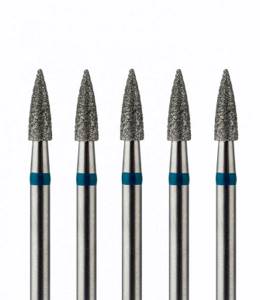
Thanks to diamond chips, which prevent injuries, this type of cutter is used for various tasks in both manicure and pedicure. Based on the manufacturing method, there are 2 types of diamond bits:
- Besieged . They have a metal base dusted with diamond chips. Purpose: polishing, polishing the nail plate, removing cuticles and treating the skin.
- Sintered , the surface of which consists of crumbs mixed with an adhesive base. Designed for rougher treatment - removing calluses and rough skin, removing artificial turf and correcting them.
To cover the nozzles, 2 types of crumbs are used:
- Artificial . Cheaper than natural. But at the same time with a limited service life (up to 4 months).
- Natural . Suitable for all types of processing. Does not heat up and has a long service life.
Advantages:
- durability;
- versatility;
- variety of species.
Diamond bits have no particular disadvantages. The service life is from 3 to 4 months.
Corundum
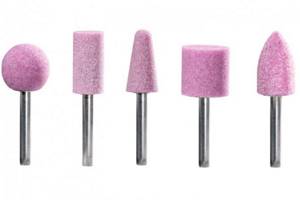
Corundum cutter is one of the varieties of ceramic . Ideal for treating weakened nails and thin, sensitive skin. Most often used for final work - grinding and polishing. The advantages of corundum nozzles include:
- versatility (works well with both sensitive areas and rough skin and artificial surfaces);
- does not irritate or cause an allergic reaction;
- heat resistance;
- strength;
- multifunctionality;
- no pain during treatment.
The only disadvantage of a corundum cutter is that it quickly becomes clogged due to the presence of scars on the surface. Service life – 3 months.
Ceramic

Ceramic attachments are considered one of the best for high-quality and safe manicure. They can be used to work on skin, natural and artificial nails. The main advantages of this type of attachments include :
- versatility;
- no heating;
- there is no risk of developing allergies, since it removes with small shavings and not dust like other types of attachments;
- practically does not clog.
Minuses:
- high price;
- low service life (only 2 months);
- Doesn't work well on very rough skin.
Reference! It is important to know that the ceramic cutter is very fragile and can be easily damaged if handled carelessly.
Safety cutters
Milling cutter attachments remain dangerous in 90% of cases if the basic rules of use are not followed. The manicure device is selected taking into account the purpose, as there are professional models and those created for home use.

Security aspects:
- tilt angle;
- pressure intensity;
- abrasiveness of the cutter;
- selecting the rotation speed of the rotating element in the handle.
Silicone carbide grinders are considered the safest. They are convenient for basic manipulations: cleaning rollers, pterygium and cuticles.
Another safe tool is a corundum stone. It has no notches, only ribs that cut off soft burrs at high speeds. If positioned incorrectly in relation to the nail, it may leave cuts.
A set of cutters for home hardware manicure
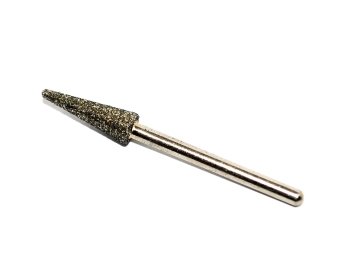
Are you thinking about what cutters a beginner will need to do a hardware manicure at home? Pay attention to ceramic products that are good at removing excess length on your (that is, natural) nails.
To care for gel nails, you will need a cone-shaped diamond cutter. It creates an internal curve and arch, and also removes unnecessary layers of gel from the underside of the free edge.
Recommendations for choosing cutters
For beginners, it is enough to have a minimum set of 2-3 cutters. These are universal attachments for cleaning pterygium and polishing the integument. Additionally, you can purchase a tool for removing artificial turf.
Professionals who master hardware manicure techniques can have up to 30-40 different attachments - each client requires an individual approach in choosing abrasiveness and cruelty. Separately, cuticle cutters are needed, but working with them requires experience and good technique.
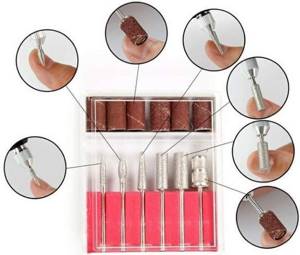
Beginners will definitely need:
- Diamond nozzles "bullet", "flame" and "cone" with red notches. They are required to separate and lift the cuticle and polish the side ridges.
- A “ball” of medium abrasiveness with a blue notch is needed in reserve for removing the cuticle and processing the outside of the side rollers. It is recommended to take a cutter measuring 1.2-2.1 mm in diameter.
- A diamond cone is useful in cleaning the pterygium.
- To remove material and color, you need a carbide tool, for example, a drum or cylindrical shape.
- Ceramic “corn” is suitable for pedicure gel polish.
- Silicon carbide caps with rubber tips are the basis in pedicure - needed for smoothing, cleaning and cutting soft skin.
- Diamond “needles” with a diameter of 1-2.2 mm and a length of 12-16 mm are used to clean shallow cracks on the legs.
Beginners are advised to choose cutters with blue and red notches. In addition to the markings, you should pay attention to the tips. They should be round so as not to get hurt.
You can buy attachments in a nail supply store or order them on the manufacturer’s website. Starter kits are sold individually or together with the milling unit.
List of the best brands:
- RuNail – high-quality materials for attachments.
- Naomi 24 and JessNail supply cutters to the international market and are in demand among the best nail industry professionals.
- Magic Bits presents a wide range.
- Irisk Professional is a better combination of cost and quality of materials.
- TNL Professional supplies inexpensive models of the HDFreza line for professional and beginner craftsmen.
- Planet Nails are affordable milling cutters for professional and manual milling machines.
The listed market favorites set different prices depending on the purpose of the nozzles and materials. The cost of the most affordable tool starts from 100 rubles. per unit and up to 1000 rub.
How to choose?
The milling cutter is the main working tool. Its choice is dictated by the feeling of comfort from use. But it is more important to know the technical nuances on which the quality of the service depends.
The choice of a professional is focused on:
- Functional purpose (only for pedicure, manicure or both).
- Shelf life (directly determined by the number of potential customers expected to be served).
- Dimensions (the dimensions of the holder must match the router).
- Form (there are no general recommendations here; the configuration of the instrument is determined only by the specifics of the upcoming manipulation).
- Diameter (foot treatment involves grinding large areas of skin, therefore miniature devices will be useless or ineffective).
Each master eventually gives preference to a particular manufacturer. At the beginning of your career, it is recommended to take into account the personal experience of colleagues and their advice. Judging by the reviews, the following brands are very popular: IRISK PROFESSIONAL, CRYSTAL, TNL, RUNAIL.
When to change attachments?
Carbide cutters are similar to metal cutters, but their service life is much shorter. Ceramic tips are produced quickly. They are enough for 45-50 material removals, and their cost reaches 600 rubles. per unit of goods.

Attachments for manicure apparatus made of steel are more durable. You can distinguish them from carbide ones by their color - it is darker. Their cost starts from 600 rubles. And ceramic cutters will last longer than all analogues. You can change a new nozzle only after 3-4 years.
Metal cutters coated with gold or titanium do not have a specific service life. You need to monitor the thickness of the grains. When the metal base is visible, you need to change the tool.
Diamond galvanic cutters will last up to 7 years and will last for 50-60 manicures. Economical pedicure tools cost approximately 50-500 rubles, but the service life reaches from 1 to 3 weeks. Ceramic thin attachments for pedicure remove coating well only for 3-4 months, then they need to be changed.
Sterilization rules
Instruments are disinfected after each use.
Cleaning consists of 3 stages:
- First, disinfection is carried out according to the instructions “Rotary instruments”. An alkaline reaction solution is used when adding active detergent components. Such agents as Aktibor, Mistral, Multidez are used. The last 2 are concentrates - they need to be diluted in water.
- Pre-sterilization is the second stage of PSO, which involves the destruction of fungi, bacteria, and viruses. The composition should dissolve and soften the remaining biological material. Skin, dirt, and gel residues are cleaned from the porous structure of the cutters. If you immediately place the nozzle in the dry heat, the blood and skin will be baked, but not cleaned. It is necessary to clean any remaining components from the cutters and wash them with detergents.
- Sterilization is heat treatment in a special unit. You can use an autoclave or dry heat. The latter sterilizes instruments at 180 °C for 60 minutes in kraft paper bags.
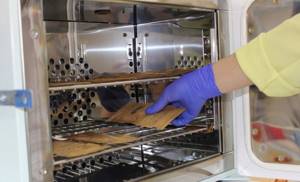
Drying prevents corrosion, so even the highest quality tools should be treated this way. The autoclave operates on the principle of high pressure but at low temperatures. The full sterilization cycle is 30 minutes.
The modes should be selected in relation to the sizes of the cutters and their notches. The larger the nozzle and the higher the abrasiveness, the longer and more carefully the tools need to be processed.
Rating of the best nozzles, cost
The most popular attachments are those that can cope with a wide range of “responsibilities”.
It is worth highlighting the main ones, without which no manicure or pedicure can be performed:
- Magic Bits – wide range and affordable prices. The manufacturer supplies excellent carbide attachments and grinding tools.
- Mühle Maniküre – an excellent range of cutters. The most durable of them are made of ceramics. Ball- and cone-shaped instruments are in great demand.
- Barrel Ball is great value for money. The manufacturer supplies good “corn”, in which the notches “look” in different directions. This ensures uniform removal of material regardless of switching reverse on the router.
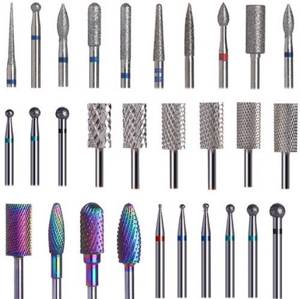
The cost of attachments from Magic Bits varies from 400 to 700 rubles. Milling cutters from Mühle Maniküre cost between 1000-1500 rubles. These are the most expensive tools, and Barrel Ball boasts affordable attachments at different price points. You can buy cutters from them for 100-300 rubles.
Nozzles are selected exclusively according to functional features and intended purpose.
Universal cutters with spraying and fine threads are suitable for all manicure devices. Depending on the power of the unit, work with thick leather and dense materials can take place at a speed of 20,000 rpm. Weak cutters require higher speed even when working with cuticles - to cut it, you need to increase the number of revolutions of the rotating element of the handle to 35,000 rpm.
But how to make the right choice?
Focus on the brand. Some people believe that it is better to give preference to foreign manufacturers, while others believe that the domestic beauty industry is quite capable of providing manicurists with everything they need. But in fact, what is important here is not the country of production, but the duration of work on the market, customer reviews and other similar factors. That is, you should choose among companies that have earned the trust of consumers.
If you decide to do manicure professionally, then the tools should be appropriate, as well as consumables. Don’t be fooled by too low a price (well, quality doesn’t come cheap), but you shouldn’t buy too expensive products either. Remember that premium brands often mark up the price for the brand, and not at all for the quality. As a rule, the best choice is always the “golden mean”.
If you can’t decide, try consulting with colleagues on forums and social networks.
An alternative option is to talk with the master teacher from whom you were trained. In general, there should be no problems with advisors. But here too, do not forget to be guided by the principle of reasonableness.
We have selected for you some practical advice from experienced craftsmen that will help you when purchasing the main characters of our publication, that is, cutters:
- When choosing attachments, consider the “global” nature of your services. If you plan to do manicures for clients, then you will have to choose an expanded arsenal. If you want to do a manicure only for yourself and a couple of friends, then it is enough to purchase a minimum of tools;
- When buying cutters, focus on the machine and the type of its mounting. also take into account the material used to make the nozzles, since it depends on the area of application, service life, and, of course, price;
- Purchase tools and consumables only from online stores and specialized departments. Avoid fakes and counterfeits. Carefully. relate to the market and private “outbids”;
- Do not forget about some (albeit minimal) differences between manicure and pedicure cutters. In the latter case, in addition to the main ones, pay attention to specialized attachments designed to remove corns and calluses.
Note! In addition to cutters and other tools, any manicurist will have to acquire a disinfection device. It is not recommended to carry out work without it, because you can easily introduce an infection, including by transmitting it from one person to another. Therefore, when buying cutters, think about buying a sterilizer (some cutters can also be disinfected, it all depends on the source material).
